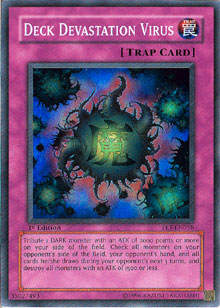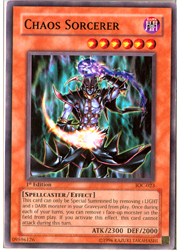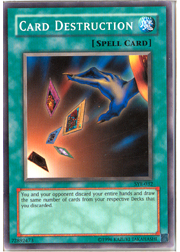Rewind to my older article on originality.
 The gist of that article was that an original combination could only fly if the combo’s win condition generated enough advantage to justify using it over the standard, stable cookie-cutter builds. Enter Deck Devastation Virus, a previously restricted card that I (and many other professional duelists) had been experimenting with prior to Shonen Jump Long Beach.
The gist of that article was that an original combination could only fly if the combo’s win condition generated enough advantage to justify using it over the standard, stable cookie-cutter builds. Enter Deck Devastation Virus, a previously restricted card that I (and many other professional duelists) had been experimenting with prior to Shonen Jump Long Beach.
Of course, the environment there turned out to be a bit more aggressive than the slower tempo matches at Durham and Orlando, so the different Deck Devastation Virus variants did not make as big a splash as anticipated. Players such as Tony Lee and Wilson Luc fell short of achieving Top 8 berths. Yet the mechanism of advantage behind Deck Devastation Virus still lingers, and it can’t be ignored, especially in light of its semi-limited status. This article will focus on its powers and how best to maximize the value of the card within any given game.
Is the Card Worth Using? A Few Sample Scenarios
Depending on how the new format shapes up, you can expect about five to twelve of your opponent’s twenty monsters to be 1500 ATK or lower. Let’s take a look at the candidates for use with Deck Devastation Virus. We need Dark monsters with ATK values higher than 2000, and only a few truly fit the bill. To generate maximum advantage with the combo, we want to tribute a “floater” monster with Deck Devastation Virus—a monster that’s already received effects, thus making its presence on the board “free.” This term includes cards like flipped Magician of Faiths and Dekoichi the Battlechanted Locomotives, Sangans, Treeborn Frogs, and Spirit Reapers that have already hit directly once. All of these are good examples of floater monsters.
The two best floaters are a bit difficult to use at will. Chaos Sorcerer, which can use priority to remove an opponent’s monster from the game, and Blowback Dragon, which can flip with priority to destroy any spell, trap, or monster, are the two best monsters to use with Deck Devastation Virus. Of these two, Chaos Sorcerer is superior. It requires no tribute, has a surefire +1 effect, and poses a threat that your opponent simply cannot ignore.
The idea behind Deck Devastation Virus is to create a 1-for-1 trade with the original 2000 ATK monster (which is rather difficult), and then to create another 1-for-1 trade with the card that your opponent will use to try to destroy your 2300 ATK floater. I’ll give you a few sample scenarios.
Let’s say your opponent has four cards in hand and Cyber Dragon on the field. You summon Chaos Sorcerer, remove Cyber Dragon, and set Deck Devastation Virus. You will not use it until your opponent plays either a piece of monster removal, a spell or trap removal, or a defensive trap like Sakuretsu Armor on your next turn.
If you wait until the opponent activates Sakuretsu Armor, the combination looks something like this—your Deck Devastation Virus and Chaos Sorcerer will trade for the opponent’s Cyber Dragon and Sakuretsu Armor. Now, take a look at your opponent’s next four cards and two draw phases. If you discard one monster, you get a 3-for-2 trade. If you discard two, you get a 4-for-2 trade. If you discard three, you get a 5-for-2. The advantage can scale up to something like a 6-for-2, or even a 7-for-2 trade!
In another example, your opponent has two cards in hand and a set spell or trap. You summon Zombyra the Dark and set Deck Devastation Virus. Again, you’ll want to wait until he or she activates a set spell or trap. However, because Zombyra is not a floater, the trade looks something like this—your Deck Devastation Virus and Zombyra the Dark for the opponent’s Sakuretsu Armor. Take a look at the opponent’s two cards in hand and two draw phases.
In this case, you’re looking at about a 2-for-2 or perhaps 2-for-3 trade. This still generates a hefty amount of advantage, but the unwieldiness of holding Deck Devastation Virus until it can be used can decrease its usefulness.
In general, however, Deck Devastation Virus can trigger massive advantage that definitely makes the card worth using. Here are a few general strategic considerations to keep in mind when using the card.
Maximizing the Usage of Your Brand-New Deck Devastation Virus Combo!
 First, there are only a few select monsters that can be used with the card. The best targets are the aforementioned Chaos Sorcerer and Blowback Dragon. Another great choice is the Dark World monsters, Goldd and Sillva. If you can find a way to discard them through Graceful Charity or Card Destruction, they can also become high-advantage floaters. And the final, best option is Dark Magician of Chaos.
First, there are only a few select monsters that can be used with the card. The best targets are the aforementioned Chaos Sorcerer and Blowback Dragon. Another great choice is the Dark World monsters, Goldd and Sillva. If you can find a way to discard them through Graceful Charity or Card Destruction, they can also become high-advantage floaters. And the final, best option is Dark Magician of Chaos.
After you pass these floaters, you start moving into murky territory. Cards like Terrorking Archfiend, Giant Orc, Zombyra the Dark, and Vampire Lord aren’t the greatest targets for Deck Devastation Virus’s effect. They’re all non-floaters that count as one hard monster cost.
Also, except in certain rare situations, you’ll want to put the burden on your opponent to remove your monster with a spell or trap effect before triggering Deck Devastation Virus. This will allow you to get another +1 advantage. The exception is if you know your opponent has set something like Morphing Jar or Magician of Faith to retrieve a game-breaking spell card, or another monster like either of these. Getting the +1 advantage from wasting the opponent’s effect is almost always worth the cost of holding your trap, except in rare instances.
Also, keep in mind that a closed game or a slow-tempo duel naturally favors the Deck Devastation Virus player far more than a quick, aggressive pace. After all, if your opponent has six cards in hand and two monsters on the board, chances are far greater that you’ll get multiple cards in one shot.
Creating a Deck that takes Advantage of Deck Devastation Virus
The preferred method, as you could probably tell, is using three copies of Chaos Sorcerer. To fuel your Light monsters in this scenario, you should use a diverse group, since Nobleman of Crossout is back in twos. A good monster lineup could look something like this.
Monsters: 20
3 Chaos Sorcerer
2 Cyber Dragon
1 Dark Magician of Chaos
1 Blowback Dragon
2 Magician of Faith
2 Magical Merchant
1 Skelengel
1 D. D. Warrior Lady
1 Sangan
1 Breaker the Magical Warrior
2 Gravekeeper’s Spy
3 Spirit Reaper
This line creates numerous floaters that can then be used to sacrifice for Blowback Dragon or Dark Magician of Chaos. It also enables you to mill through your deck effectively, and adds plenty of Light and Dark monsters to use for Sorcerer. An alternative lineup could look something like this.
Monsters: 21
3 Goldd, Wu-Lord of Dark World
3 Sillva, Warlord of Dark World
2 Chaos Sorcerer
3 Thunder Dragon
1 D. D. Warrior Lady
2 Magician of Faith
1 Sangan
1 Breaker the Magical Warrior
3 Spirit Reaper
2 Magical Merchant
 This lineup would obviously exploit synergies with cards like Card Destruction and Dark World Lightning. This method has far swifter abilities to bring your 2300 ATK monsters to the field. However, the basic idea remains intact. The goal is to create floaters with the tribute condition for Deck Devastation Virus.
This lineup would obviously exploit synergies with cards like Card Destruction and Dark World Lightning. This method has far swifter abilities to bring your 2300 ATK monsters to the field. However, the basic idea remains intact. The goal is to create floaters with the tribute condition for Deck Devastation Virus.
Concluding Thoughts
Always keep in mind that Deck Devastation Virus is a metagame-dependent tool. If your opponent is running only monsters with 1600 ATK or higher, Deck Devastation Virus will have no effect. The wily player would be wise to keep an eye open for the decklists of future Shonen Jump Championships, as the format slowly sorts itself out. Deck Devastation Virus prospers in a closed tempo where lots of weaker monsters are being set while hands overflow with options.
As with other pieces of disruption like Confiscation and Trap Dustshoot, the ability to see the opponent’s hand is worth a few points of advantage in and of itself. When you play Confiscation to see your opponent’s hand, you’re immediately privy to his or her strategy for the next few turns. Not only do you get to cut off the most imminent threat, but you also can prepare for all the minor threats as well.
Deck Devastation Virus works the same way. The effect basically makes you immune to hand disruption (Spirit Reaper will be eliminated), and makes it difficult for your opponent to attack you without the help of cards like Call of the Haunted and Premature Burial.
The top players in this game are attracted to the card because it trades two to three resources for complete mastery of the field for three turns. You have the potential to swing anywhere from 2-for-3 trades to +4 or +5, which can effectively seal the duel in your favor. It’s difficult to tell what impact Deck Devastation Virus will have in the upcoming format, but the fact that the card can be a dead draw makes it highly difficult for all but the best deck builders to splash multiple copies. If the format shifts to higher-ATK monsters, it’ll become even more difficult.